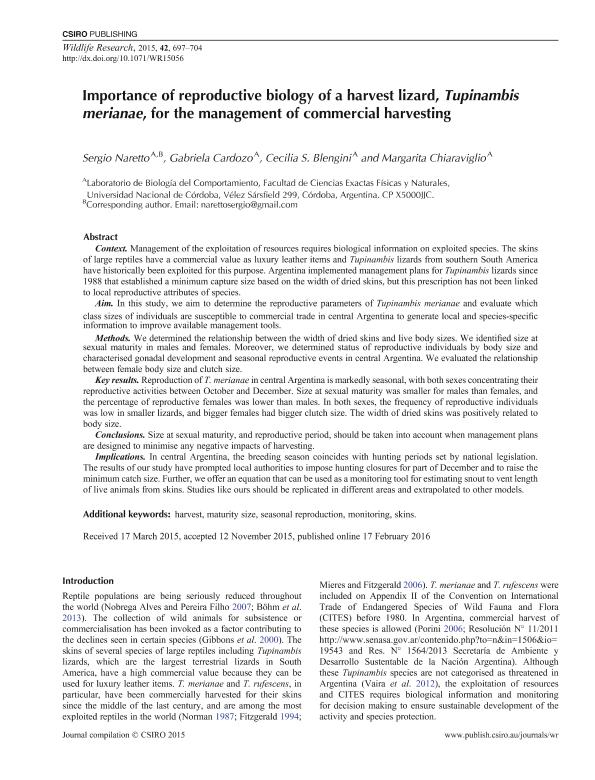Artículo
Importance of reproductive biology of a harvest lizard, Tupinambis merianae, for the management of commercial harvesting
Naretto, Sergio ; Cardozo Milanesio, Gabriela Alejandra
; Cardozo Milanesio, Gabriela Alejandra ; Blengini, Cecilia Soledad
; Blengini, Cecilia Soledad ; Chiaraviglio, Margarita
; Chiaraviglio, Margarita
 ; Cardozo Milanesio, Gabriela Alejandra
; Cardozo Milanesio, Gabriela Alejandra ; Blengini, Cecilia Soledad
; Blengini, Cecilia Soledad ; Chiaraviglio, Margarita
; Chiaraviglio, Margarita
Fecha de publicación:
01/2016
Editorial:
Csiro Publishing
Revista:
Wildlife Research
ISSN:
1035-3712
e-ISSN:
1448-5494
Idioma:
Inglés
Tipo de recurso:
Artículo publicado
Clasificación temática:
Resumen
Context Management of the exploitation of resources requires biological information on exploited species. The skins of large reptiles have a commercial value as luxury leather items and Tupinambis lizards from southern South America have historically been exploited for this purpose. Argentina implemented management plans for Tupinambis lizards since 1988 that established a minimum capture size based on the width of dried skins, but this prescription has not been linked to local reproductive attributes of species. Aim In this study, we aim to determine the reproductive parameters of Tupinambis merianae and evaluate which class sizes of individuals are susceptible to commercial trade in central Argentina to generate local and species-specific information to improve available management tools. Methods We determined the relationship between the width of dried skins and live body sizes. We identified size at sexual maturity in males and females. Moreover, we determined status of reproductive individuals by body size and characterised gonadal development and seasonal reproductive events in central Argentina. We evaluated the relationship between female body size and clutch size. Key results Reproduction of T. merianae in central Argentina is markedly seasonal, with both sexes concentrating their reproductive activities between October and December. Size at sexual maturity was smaller for males than females, and the percentage of reproductive females was lower than males. In both sexes, the frequency of reproductive individuals was low in smaller lizards, and bigger females had bigger clutch size. The width of dried skins was positively related to body size. Conclusions Size at sexual maturity, and reproductive period, should be taken into account when management plans are designed to minimise any negative impacts of harvesting. Implications In central Argentina, the breeding season coincides with hunting periods set by national legislation. The results of our study have prompted local authorities to impose hunting closures for part of December and to raise the minimum catch size. Further, we offer an equation that can be used as a monitoring tool for estimating snout to vent length of live animals from skins. Studies like ours should be replicated in different areas and extrapolated to other models.
Palabras clave:
Harvest
,
Maturity Size
,
Monitoring
,
Seasonal Reproduction
,
Skins
Archivos asociados
Licencia
Identificadores
Colecciones
Articulos(IDEA)
Articulos de INSTITUTO DE DIVERSIDAD Y ECOLOGIA ANIMAL
Articulos de INSTITUTO DE DIVERSIDAD Y ECOLOGIA ANIMAL
Citación
Naretto, Sergio; Cardozo Milanesio, Gabriela Alejandra; Blengini, Cecilia Soledad; Chiaraviglio, Margarita; Importance of reproductive biology of a harvest lizard, Tupinambis merianae, for the management of commercial harvesting; Csiro Publishing; Wildlife Research; 42; 8; 1-2016; 697-704
Compartir
Altmétricas



